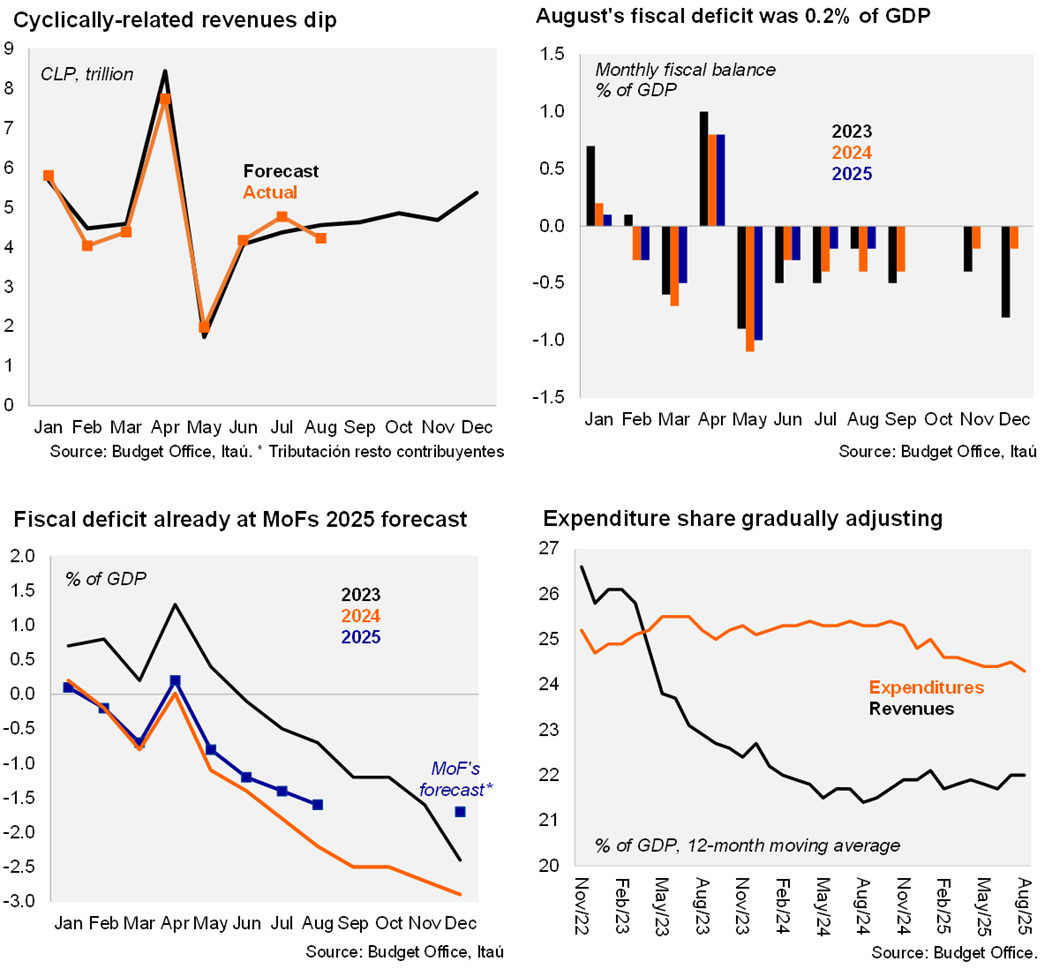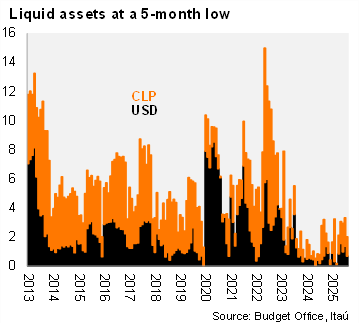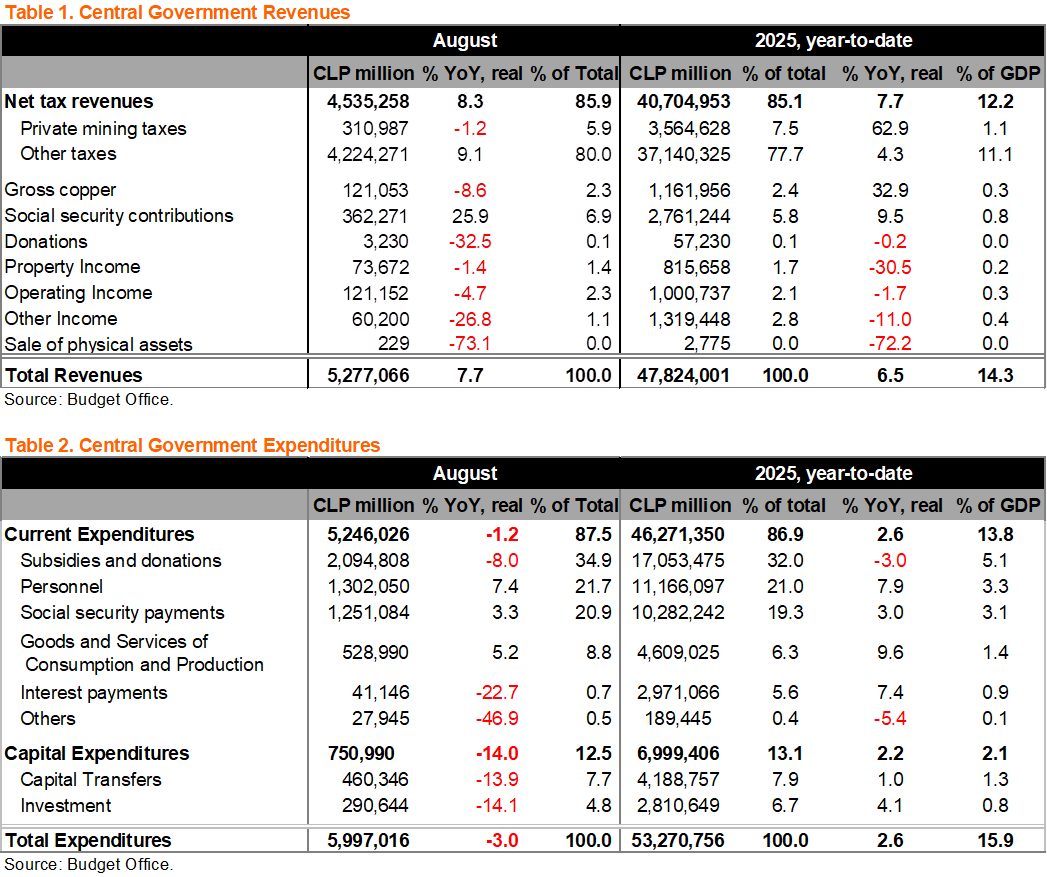2025/10/01 | Andrés Pérez M., Vittorio Peretti, Andrea Tellechea & Ignacio Martínez
While all eyes are now on the 2026 budget bill, ongoing fiscal consolidation efforts this year are welcome yet are likely to fall short, leading to deficits above the official forecasts.
The Central Government’s real revenues rose by 7.7% in August, after an important 19.4% increase in July. Cyclically-related real revenues (tributación resto contribuyentes, comprising roughly 80% of total revenues) rose by 9.1% YoY, after rising by 19.4% in July, influenced by lower returns from tax season which also affected July; these revenues were slightly below our forecast, taking cumulative misses in the year to 2% (see chart). Even though private mining revenue fell again on an annual basis in August, these revenues in the year are up by 62.9% YoY, reflecting the first full year of the new mining royalty law, elevated copper prices, and greater copper production. Total real revenues accumulated in the year through August have increased by 6.5% YoY (6.3% in July), inching up towards the MoF’s annual 7.6% forecast (does not consider greater revenues from “corrective measures”, which mostly rely on legislative approval).
Real spending fell by 3.0% YoY in August. Current expenditure declined by 1.2%, mainly driven by a 22.7% contraction in interest payments (base effects) and an 8.0% decrease in subsidies and donation, while most of the other items rose on an annual basis; current expenditures year-to-date are up by 2.6% accumulating 66.6% of the annual budget, in line with 2024. Capital expenditure fell by 14.0% YoY, leading to a cumulative rise in the year of 2.2%, taking this component’s expenditure to 53.5% of the annual budget, slightly below last year’s progress at the time (54.1%). We believe that after frontloading in the first half of the year, capital spending is likely to slow. Total spending in the year through August has increased by 2.6%, gradually falling towards the 2.2% official forecast.
August’s monthly fiscal balance reached -0.2% of GDP, halving last year’s August deficit. The cumulative fiscal balance through August rose to a deficit of 1.6% of GDP, a smaller deficit than the 2.2% through August in 2024 (see chart).
The 12-month rolling fiscal deficit fell further to 2.3% of GDP, from 2.5% of GDP in July. On a 12-month moving average basis as of the end of August, the central government’s revenues were flat at 22.0% of GDP, and expenditures fell slightly to 24.3%, leading to a nominal deficit of 2.3%, improving from 3.9% of GDP a year earlier. We expect a gradual narrowing of the deficit, primarily due to an improvement in revenues.
Liquid assets at the Treasury fell at the margin in August. Liquid assets in the Treasury fell at the margin to USD2 billion in August (from USD3.3 billion in July), slightly below July 2024’s level (USD2.8 billion). Despite the sequential decline, cash buffers are improving, driven by debt issuance and greater revenues, as we have mentioned in previous reports. AUM in the sovereign wealth funds were little changed, likely reflecting valuation effects. The Stabilization Fund (FEES) was flat at USD3.86 billion, and the Pension Reserve Fund (FRP) was up slightly to USD9.9 billion. The USD200 million twenty-year loan from the PRF to the social security fund (as part of the implementation of the pension reform) is not reported as a withdrawal, rather still included in the AUM. Loans totaling USD900 million (including this year’s USD200 million) are projected to take place in the following years through 2027; see our report on sovereign wealth funds here.
Our take:
• Again, revenue improvements are taking place in line with our view for the fiscal accounts, leading us to be more constructive than consensus. Still, spending growth will have to contained during election season. Our 2025 nominal deficit forecast of 2.0% of GDP implies a deficit of only 0.4% of GDP for the September-December period, well below the 0.8% of last year during the same period.
• On the financing front: The MoF announced an upward revision to the 2026 gross financing plan (from USD16 billion to USD16.7 billion) along with its 4Q25 local currency issuance plan. See our note on the issue here.
• On policy and reforms: The revenue-neutral tax reform – according to official estimates – presented by the administration in July is likely to face resistance in Congress as elections loom in November. The legislative branch will focus on the 2026 budget discussions for the next 90 days. Measures that enhance this year’s revenues – so called corrective measures – remain in discussion in Congress.
• Upcoming data: The Budget Office will release September’s fiscal by the end of October.




